Ilfracombe is a town on the North Devon coast. This is a list of notable individuals who are associated with Ilfracombe in some way, listed alphabetically within categories.
Ilfracombe is a town on the North Devon coast. This is a list of notable individuals who are associated with Ilfracombe in some way, listed alphabetically within categories.

Ilfracombe is a seaside resort and civil parish on the North Devon coast, England, with a small harbour surrounded by cliffs.

Vice Admiral Cuthbert Collingwood, 1st Baron Collingwood was an admiral of the Royal Navy, notable as a partner with Lord Nelson in several of the British victories of the Napoleonic Wars, and frequently as Nelson's successor in commands.
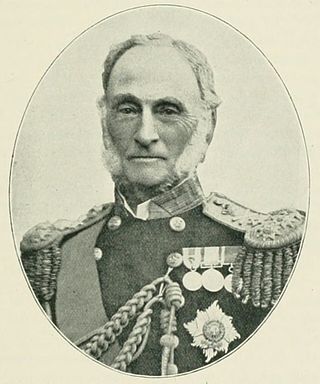
Admiral of the Fleet Sir Geoffrey Thomas Phipps Hornby GCB was a Royal Navy officer. As a junior officer, he saw action at the capture of Acre in November 1840 during the Egyptian–Ottoman War. As a captain, he was assigned to Vancouver Island with a naval brigade where he found a unit of United States troops ready to take over the San Juan Islands in a dispute that became known as the Pig War. Hornby used his powers of diplomacy to facilitate a peaceful handover of the islands to the United States.

HMS Neptune was a 98-gun second-rate ship of the line of the Royal Navy. She served on a number of stations during the French Revolutionary and Napoleonic Wars and was present at the Battle of Trafalgar in 1805.
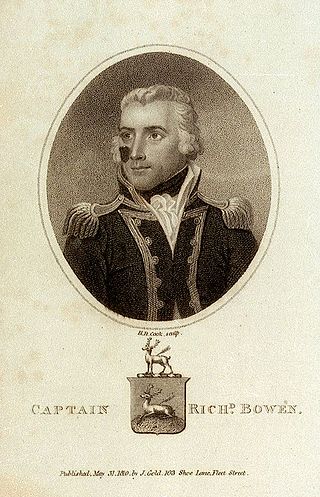
Richard Bowen was an officer of the Royal Navy who served during the American War of Independence and the French Revolutionary Wars. Bowen saw service with Horatio Nelson, and was killed fighting alongside him at the Battle of Santa Cruz de Tenerife.

Admiral of the Fleet Sir James Alexander Gordon, GCB was a Royal Navy officer. As a volunteer, he fought at the Battle of Groix, at the Battle of the Glorious First of June and at the Battle of Cape St Vincent during the French Revolutionary Wars and then, as a midshipman, served under Admiral Sir Horatio Nelson at the Battle of the Nile.

James Bowen was an officer of the Royal Navy.

John Coulson Kernahan was an English novelist.

Rear-Admiral John Bowen was an English Royal Navy officer and colonial administrator, who led the first settlement of Tasmania at Risdon Cove.
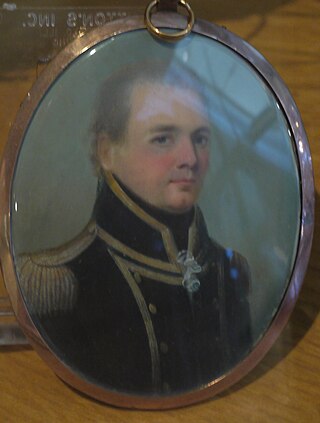
Captain John Richards Lapenotière was a British Royal Navy officer who, as a lieutenant commanding the tiny topsail schooner HMS Pickle, observed the Battle of Trafalgar on 21 October 1805, participated in the rescue operations which followed it and then carried the dispatches of the victory and the death of Admiral Nelson to Britain.
Captain Stephen Wentworth Roskill, was a senior career officer of the Royal Navy, serving during the Second World War and, after his enforced medical retirement, served as the official historian of the Royal Navy from 1949 to 1960. He is now chiefly remembered as a prodigious author of books on British maritime history.

Admiral Sir Sydney Colpoys Dacres, was an officer of the Royal Navy who saw service during the Greek War of Independence, when he was involved in an attack on the Turkish forces at Morea, and later during the Crimean War. Born into a substantial naval dynasty during the Napoleonic Wars, he eventually rose to the rank of Admiral and became First Naval Lord. His only significant action as First Naval Lord was to press for the abolition of masts. He went on to be Visitor and Governor of Greenwich Hospital.

Emilia Francis Strong, better known as Emilia, Lady Dilke, was a British author, art historian, feminist and trade unionist.

The action of 13 October 1796 was a minor naval engagement of the French Revolutionary Wars, fought off the Mediterranean coast of Spain near Cartagena between the British Royal Navy 32-gun frigate HMS Terpsichore under Captain Richard Bowen and the Spanish Navy 34-gun frigate Mahonesa under Captain Tomás de Ayalde. The action was the first battle of the Anglo-Spanish War, coming just eight days after the Spanish declaration of war. In a battle lasting an hour and forty minutes, Mahonesa was captured.
British Cemetery Montevideo Soldiers, Sailors and Airmen contains information about servicemen of different nationalities whose tombs can be found within the Cemetery. A few of the ships mentioned are well known to the general public, such as STV Royston Grange or HMNZS Achilles, which fought in the Battle of the River Plate.
Dilke may refer to:
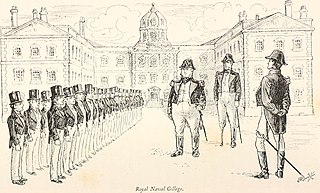
Admiral Sir John Wentworth Loring, KCB, KCH was a Royal Navy officer of the early nineteenth century who is best known for his service in the Napoleonic Wars as a frigate commander. Born in the Thirteen Colonies at the outbreak of the American War of Independence, Loring's family fled to Britain and he subsequently joined the Royal Navy aged 13. In 1793, aged 17, Loring was badly wounded in combat at the start of the French Revolutionary Wars. He subsequently served throughout the following 23 years of warfare between Britain and France, achieving success in command of the frigate HMS Niobe. After the war he served in an influential position at the Royal Naval College, Portsmouth and eventually became a full admiral.
George Thorp was an officer of the Royal Navy who saw service during the French Revolutionary Wars. His short, but distinguished, career culminated in service as first lieutenant of the frigate HMS Terpsichore and his death, aged 19, at the side of his commanding officer, Captain Richard Bowen, in the assault on Santa Cruz, Tenerife.
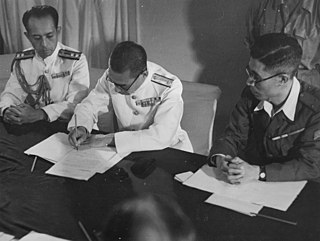
Operation Jurist referred to the British recapture of Penang following Japan's surrender in 1945. Jurist was launched as part of Operation Zipper, the overall British plan to liberate Malaya, including Singapore.
{{cite web}}: CS1 maint: unfit URL (link)